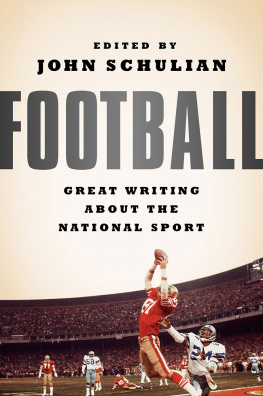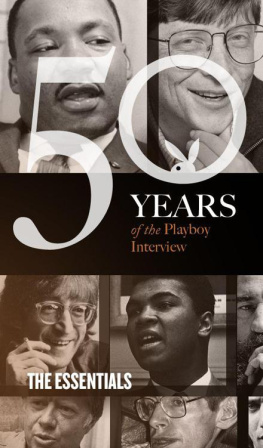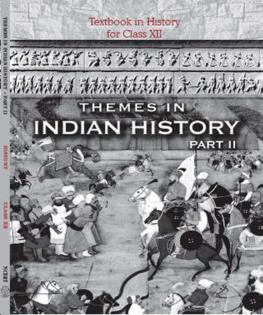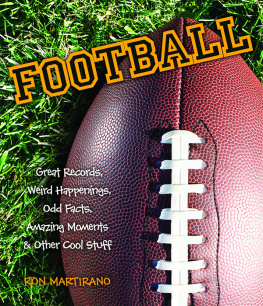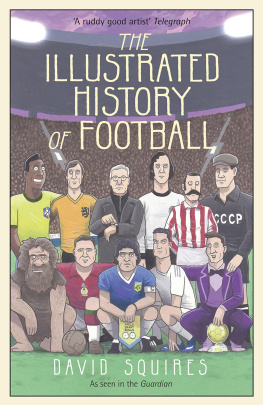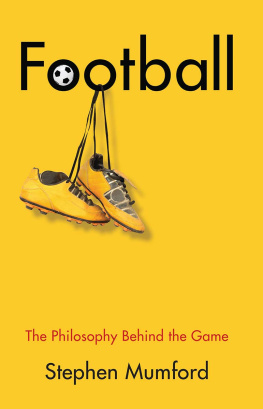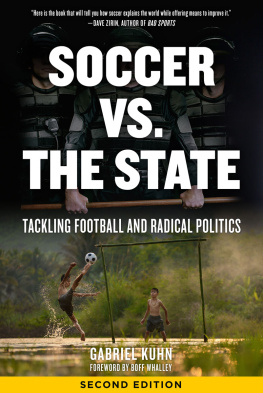
Introduction, headnotes, and volume compilation
copyright 2014 by Literary Classics of the United States, Inc.,
New York, N.Y. All rights reserved.
No part of the book may be reproduced commercially by
offset-lithographic or equivalent copying devices without the
permission of the publisher.
www.loa.org
Some of the material in this volume is reprinted with the
permission of holders of copyright and publishing rights.
Acknowledgments are on page 447.
Photograph on by Marvin E. Newman,
courtesy of Sports Illustrated/Getty Images.
THE LIBRARY OF AMERICA, a nonprofit publisher, is dedicated to publishing, and keeping in print, authoritative editions of America's best and most significant writing. Each year the Library adds new volumes to its collection of essential works by America's foremost novelists, poets, essayists, journalists, and statesmen.
If you would like to request a free catalog and find out more about The Library of America, please visit with your name and address. Include your e-mail address if you would like to receive our occasional newsletter with items of interest to readers of classic American literature and exclusive interviews with Library of America authors and editors (we will never share your e-mail address).
Library of Congress Control Number: 2013957899
ISBN 9781598533071 (Print)
ISBN 978-1-59853-367-5 (ePub)
Introduction
by John Schulian
Tackling Football
I THINK OF THE OLD FOOTBALL PRESS BOXES FIRST , the ones where youd look up from scribbling something in your notebook and find a guy in the crowd staring at you through the window, probably wondering if it was your story that made him choke on his cornflakes the other morning. When the scoreboard clock hit 0:00, hed be gone, win or lose, and youd join the media procession down to the locker room bent on making sense of what youd seen and praying you didnt get coldcocked by some joker wielding a TV camera. The head coach would tell you he wouldnt know anything until he saw the game films, and then youd get the truth from the players, who provide football with its great thumping heartbeat. Youd stay for as long as you could before the threat of your deadline forced you back to the press box to start stringing sentences together. Everybody elses day was done but work was just beginning for you and the cleanup crew.
The writers of my generation toiled on portable typewriters that were built for punishment and on primitive computers that could scar you for life where technology was concerned. One frozen afternoon in Minnesota, the Vikings turned off the heat after they won on a Hail Mary, and the three of us left in the press box, all out-of-towners, had to write with fingers we couldnt feel. Better to have been in Baltimore the day a small plane crash-landed in Memorial Stadiums upper deck barely ten minutes after a game ended. At least you could get a story out of the plane.
The story was always the thing. It was what we lived for: re-creating the drama every game is built on, pillaging our notebooks for the perfect quote, forever searching for something in the people we wrote about that maybe even they werent aware of. Our working quarters could be cramped and our deadlines tighter than the wrong pair of shoes, but the men and women who ran this gauntlet every week still felt the jolt of inspiration. If you cared about what you were doing, if you felt a connection to the game and wanted your contribution to its deadline literature to truly matter, you had to write like your pants were on fire even when you were risking frostbite.
Its my hope that the spirit of those press boxes infuses this book. Some of the pieces gathered here were written in them, the early stuff mostly, the stories that bear such legendary bylines as Red Smith and Jimmy Cannon. You dont have to search the Internet for long before you find photos of the old-timers in overcoats and fedoras as they hunched over their typewriters, cigarette smoke curling around their heads, banging out page after page and shouting for Western Union to come get it and send it. It seemed a romantic life. It was a romantic life. Those of us who got the chance to live it carry the memories no matter how far we have traveled from the press box. Yes, we cursed our forgotten field glasses, jeopardized our health with bad box lunches, and kept an eye on the clock, always the clock, but in return we covered games that people would talk about for decades to come. And with those games we got the characters and the craziness and the occasional sadness that we would turn into what so many wonderful writers shrugged off as typing. It was, at its best, much more than that.
* * *
Forgive me if I sound as puffed up as the former University of Oklahoma president who wanted a school his football team could be proud of, but the stories you are about to read go beyond scores and championships and the zeal for money, money, money that increasingly drives every aspect of the sport. What we have here is full-blooded prose that is smart, funny, poignant, impassioned, and insightful. Some stories are steeped in the relative innocence of the past. Others address the hard and uncomfortable truths that are forcing lovers of the game to reevaluate the thrill they get from a tackle that separates someone from his senses. And always there are the yarns that will live as long as tailgaters have brats on the grill.
Time unwinds in these pages, taking us all the way back to Grantland Rice, the granddaddy of modern sportswriting, as he reminisces about how he mythologized Notre Dames Four Horsemen in 1924. Hard on his heels is the master craftsman W. C. Heinz recalling the magic of a hero from his youth, Red Grange, footballs first great broken-field runner. And then there is Myron Cope, an impish wordsmith and broadcaster turned oral historian, tracking down Johnny Blood, the footloose halfback who personified what it meant to be a tramp athlete when the game dwelled on the margins of respectability. Each writer comes out of a different eraRice the Roaring Twenties, Heinz postwar America, Cope the rebellious 60s and 70sand yet they are bound by the history that provides the road map for this book.
Its the history of football, of course, but its also the history of football writing. Rices florid dispatches aside, the press started out treating the game like a neer-do-well brother-in-law. To come to some understanding of its past, your safest bet in most cases is to rely on writers of more recent vintage. So it is that two of the very best grace these pages with stories that look back at football in the middle of the last century. Gary Smith delivers a meditation on an unforgettable photo of the Texas Christian University team taken moments before its 1957 Cotton Bowl collision with Jim Brown, perhaps the greatest running back ever. Frank Deford, Smiths venerable stablemate at Sports Illustrated, taps into his hometown roots to define what Johnny Unitas meant to him and to the city of Baltimore.
Such pieces propel us to a basic truth about football coverage: what the roaring crowds and TV cameras see may not amount to half of what you can get from writers with an eye for detail, an ear for the vernacular, and a gift for asking the right questions. There are small moments, too, and small moments define football for us in ways the scoreboard never will. They demystify the coaches who scheme and rage along the sideline, and the players whose Darth Vader helmets render them faceless, and the support troops who dwell on the periphery of the heroism and the violence and the cacophony.
Next page
